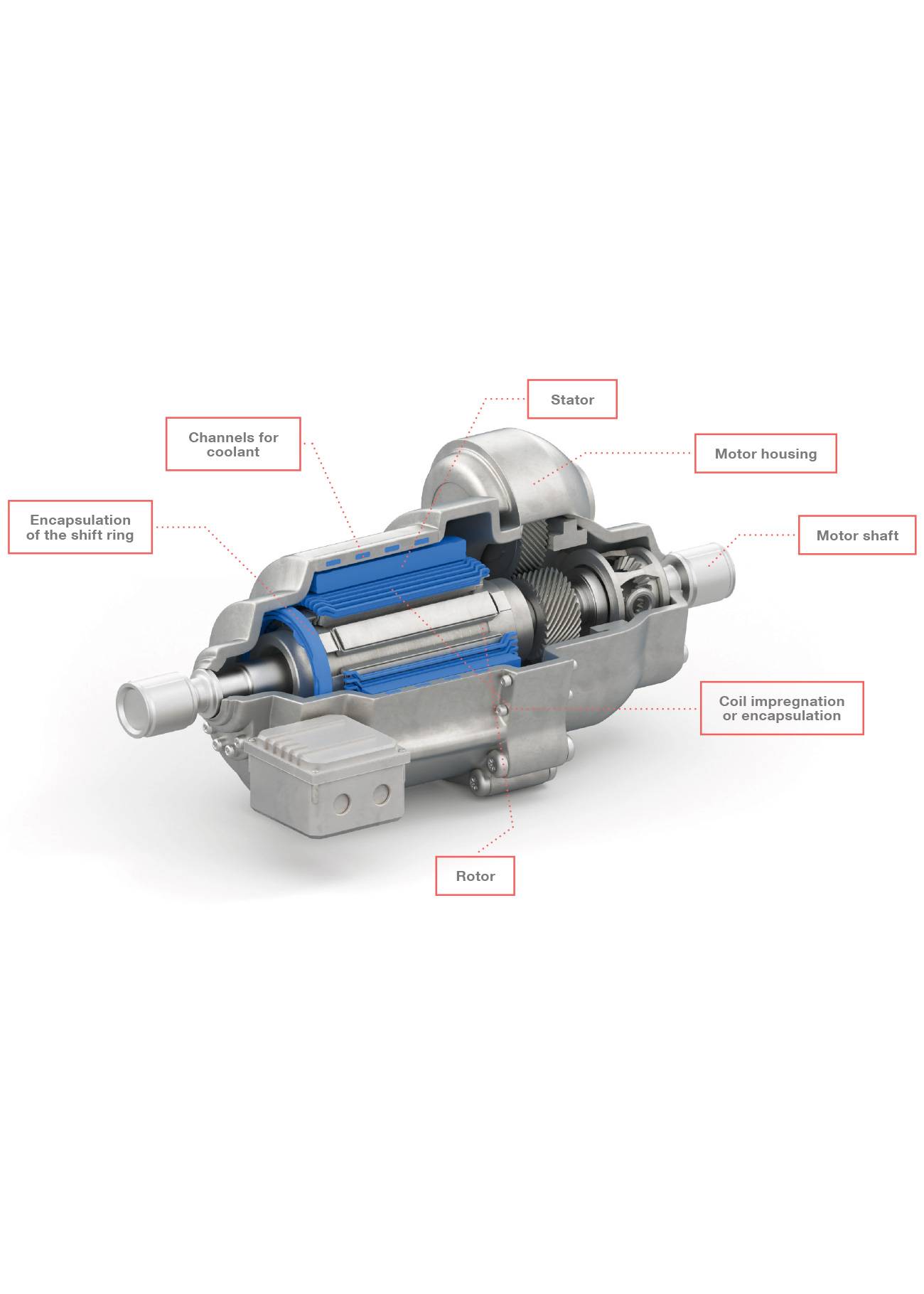
Move toward the era of electromobility
Gap fillers and heat-dissipating adhesives ensure safe heat management in electric motors, batteries and power electronics.
Mar 01, 2018 Read time: approx. MinutesMinute
An Energizing Lead
WACKER is supporting the German automotive industry’s move toward the new era of electromobility with a portfolio of custom-made silicone products: gap fillers and heat-dissipating adhesives ensure safe heat management in electric motors, batteries and power electronics. Encapsulants protect inductive charging systems and sensors for driver-assistance systems.
Around 17 percent of worldwide carbon dioxide emissions are due solely to road traffic. One solution for traffic-related emission problems is promised by e-mobility. Governments, city councils and non-government organizations see this mobility form as a way to meet the obligations agreed to in the 2015 Paris Climate Agreement on reducing greenhouse gas emissions. They are therefore supporting entry into the e-mobility market with generous financial assistance, expansion of the charging infrastructure, and preferential licensing.
Cities are also increasingly taking drastic measures – all the way up to driving bans – to accelerate this change.
Many car buyers in smog-choked Chinese mega-cities such as Shanghai and Beijing are already choosing to buy electric vehicles because they would otherwise have to wait for years to get permission, if they are lucky, for gasoline and diesel cars. China will likewise be introducing production and sales quotas for electric vehicles as of next year. Air is running out for gasoline and diesel vehicles in Europe, too: Paris, for example, aims to ban all combustion-engine vehicles from the city by 2030.
Where it’s sensible to wear a face mask: practically no other metropolis is so badly affected by smog as Beijing. Inhabitants wear these masks in an attempt to protect themselves against fine dust particles and pollutants.

The German automotive industry, which has long had a wait-and-see attitude to the topic of electromobility, is now advancing the development of electrically powered vehicles at top speed: VW has an e-Golf, while its subsidiary Audi will be marketing its first, fully electrically powered SUV – the e-tron – at the end of the year. BMW has been a pioneer in the German market with their i3 since 2013 – the Munich company is now one of the world’s largest manufacturers of electric vehicles.
0.7% of all new vehicles in Germany were sold in 2017 with a fully electric drive. 0.85% were plug-in hybrids, combining a combustion engine with an electric drive (source: European Alternative Fuels Observatory (EAFO)). Thus, not even 1% of new vehicles sold in Germany in 2017 were electrically operated.

From a customer perspective, there are three decisive weak points that make many car drivers hesitate about changing over to an electric vehicle: the significantly higher price, the sparse charging infrastructure and the fear of being stranded on the road during long journeys.
The charging infrastructure issue should be resolved over the coming years through initiatives by the automotive companies and government incentive programs. Range is also being targeted: Opel’s Ampera-e is currently the leader on the German market with a standard range of 520 kilometers on one charge.
Nevertheless, the dissemination of electric vehicles is still highly dependent on the underlying conditions that governments set: through restrictions as in China or more commonly in Europe through financial support.
In Norway, where the state subsidizes electric vehicles by not applying VAT, import or vehicle taxes, and where plenty of hydroelectric power is available, electric vehicles are often less expensive than their combustion-engine counterparts. Almost 40 percent of all those who bought new cars in Norway last year chose an electric vehicle. The market share of electric vehicles in 2017 in the major car nations, such as Germany, Japan, France and the USA, was in contrast just 1 percent or less, or between 1 and 1.6 percent if plug-in hybrids are included – but these figures are showing a significant upward trend.
During subsequent curing, the gap filler forms a soft, vibration-damping silicone cushion that optimally conducts heat to the heat sink.
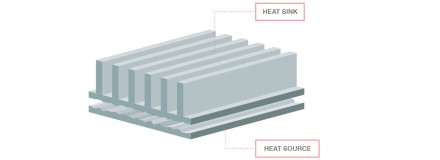
Optimized heat transfer: thermal interface materials are used to replace the air – a poor heat conductor – in the gap between the heat source and heat sink, creating a thermally conductive connection.
The third disadvantage for a buyer – the relatively high price compared to a conventional vehicle – is due to the high additional costs for the battery, which cannot be fully compensated for by the removal of other components, such as the transmission. “The industry, however, expects these additional costs to cancel out within a few years – and this is confirmed by cost developments over the past years,” said Dr. Klaus Angermaier. The chemist is responsible at WACKER SILICONES for the development of new business areas – including electromobility.
The falling prices forecast for batteries should rapidly promote the large-scale production of electric vehicles. All major manufacturers are aiming to produce electric vehicles on the same industrial scale as conventionally powered vehicles within a few years. To achieve this objective, the automotive sector is working hand in hand with the chemical industry, which will be providing the innovative materials for the new challenges posed by electromobility.
“Such demanding tasks include dissipating the heat generated in a vehicle’s electrical components during driving or charging”, said Dr. Angermaier. Another challenge is building up the infrastructure for charging the traction battery. Angermaier said, “Methods for inductive charging are currently of great interest.”
Application of a silicone-based gap filler
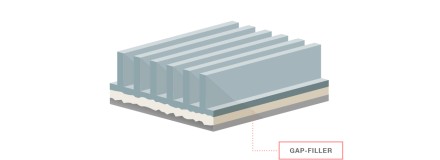
The pastes are applied by dispensing. Silicone-based thermal interface materials are ideal for filling in minute surface roughnesses and unevennesses in the millimeter range.

Kilometer-long traffic jams every day: Thailand’s capital, Bangkok, suffers from bumper-to-bumper traffic and exhaust fumes. Thailand has started a program to promote electromobility in order to reduce pollution.
Street in Bangkok

17% of worldwide carbon dioxide emissions are caused by road traffic alone.
Changes in attitude toward transport networks and energy must work hand in hand so that electromobility can help significantly reduce environmentally harmful emissions. If an electric vehicle is driven using coal-generated power, exhaust gases would not be produced locally, i.e. by the vehicle, but greenhouse gases would still be generated at the power station.
Two to three kilograms of silicone
A project group headed by Angermaier is looking very closely into which silicone materials will be required for this new form of mobility. Around two to three kilograms of silicone can be found in a midsize car’s combustion engine today. For example, silicone rubbers are used in turbocharger hoses, protective jackets for spark plug connectors and ignition cables, vibration dampers and various gaskets and sealing mats. In addition, the electronics used in the vehicle control units are protected by dispensable silicone sealing adhesives or encapsulants. Even the functional safety of an airbag significantly profits from a silicone coating, since it makes this technical textile permanently flexible and resistant to temperature, aging and wear.
Some of these silicone applications will not be required in a fully electrically powered vehicle, but other new applications will be. “Electric cars are another vehicle category where silicone materials are essential,” emphasized Angermaier. “Our objective is to have the necessary silicone products available in time for the start of industrial-scale production of electric vehicles.” The drive train of a fully electric vehicle has three key components: the electric motor, traction battery and power electronics.
The combustion engine and transmission are omitted or can be of a simpler design. The compact, but powerful electric motor provides the necessary torque for the drive in electric vehicles.
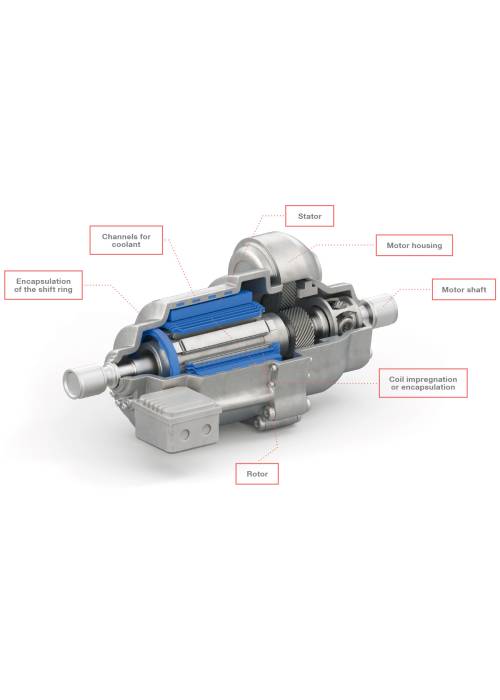
The rechargeable battery – lithium-ion batteries are currently state of the art – serves as the energy storage device. The power electronics have the task of supplying electrical energy in the required form and voltage levels, and of controlling the energy flows. They are located in power conversion units.
The electric motor, traction battery and power electronics work with high electrical outputs and generate heat during operation. If they overheat, this can lead to the aging and premature failure of the components, some of which are very expensive. The released heat must be rapidly and effectively dissipated to prevent this.
“Heat management is particularly important for lithium-ion batteries.”
Dr. Philipp Müller, head of an applications laboratory at WACKER SILICONES’ Industrial Solutions business unit
“The lithium-ion batteries only reach their full performance capability between 20 and 35 degrees Celsius and must therefore be temperature-controlled, i.e. kept within that range,” he emphasized. The traction batteries are usually installed below the passenger compartment, where they take up most of the area, and have a modular structure: several battery cells are combined into modules. Several modules are then combined to form a complete battery with an electronic battery management system, temperature-control system and a housing.
Not even the smallest air gap can be present between the assembled components so that the heat can be transported rapidly and effectively from the battery modules to the temperature-control system – or in the other direction when heating is needed. The reason is that air is a very poor heat conductor and would hinder heat transfer. The gap is therefore completely filled with a thermally conductive material called a gap filler. This forms a thermal bond between the parts being joined.
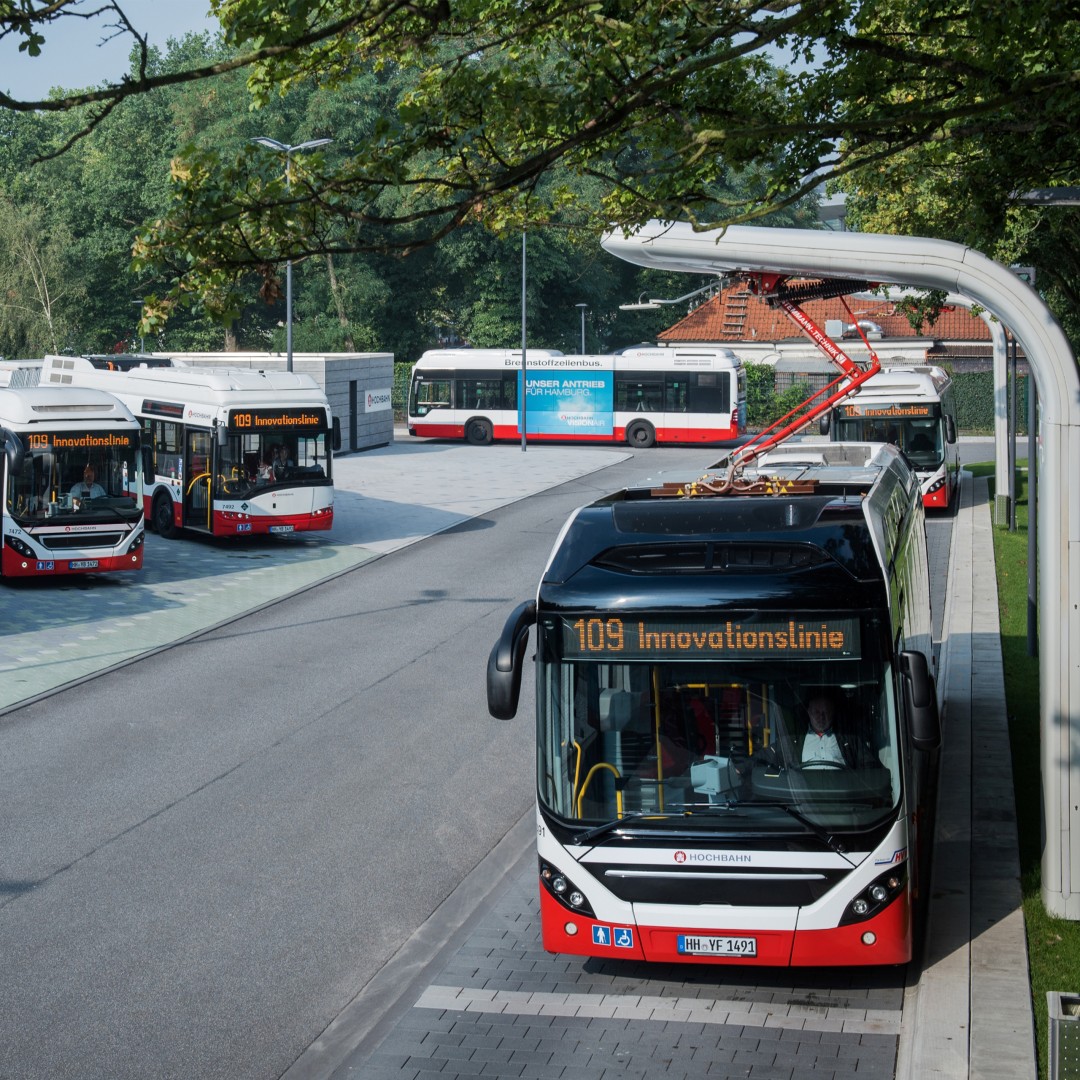
A Volvo hybrid bus operated by the Hamburger Hochbahn public transport company (HHA) at a charging station: HHA wants to convert its entire fleet of approximately 1,000 vehicles from diesel to electric drive over the next few years.
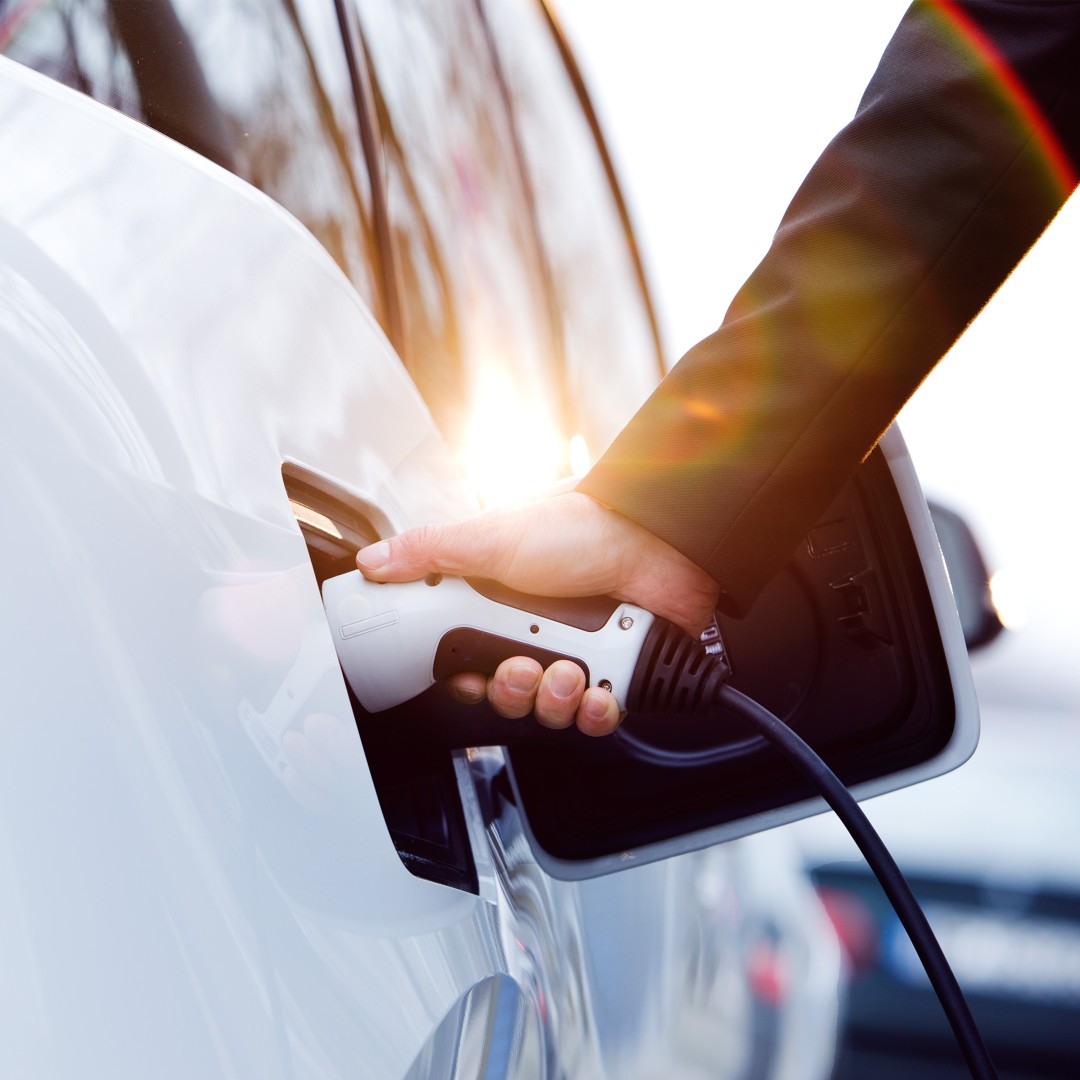
Using a charging cable instead of a gas-pump nozzle: a BMW i3 with 125 kW electric motor being charged at a public charging station.
Pastes
WACKER is offering new silicone-based gap fillers with their SEMICOSIL® 96x TC series, ideal for the thermal bonding of the battery modules with the temperature-control system. These pastes rapidly cure at room temperature with a platinum-catalyzed addition reaction. They achieve the thermal conductivity levels required in practice with values of 2 to 4 Watt per meter and Kelvin. The starting point of this development was based on products that have been used successfully for years for heat management in power electronic modules.
Like conventional products, the SEMICOSIL® 96x TC series grades form elastically deformable silicone pads in the gaps. Closely following the contours of both surfaces, these pads perfectly fill even the slightest roughness and unevenness in the millimeter range. As silicone products, such gap fillers have major advantages over products based on organic polymers. Because they do not age, they permanently ensure good heat transfer and thereby contribute significantly to the required service life and stability of charge-discharge cycles in expensive traction batteries. As they are virtually non-flammable, they also contribute to battery safety.
The processing properties are just as important for the automotive industry. “Thanks to a new formulation concept, we managed to match the flow properties of the gap fillers to the manufacturing processes of the automobile manufacturers,” explained Dr. Müller. These paste-like materials are a solid when at rest, but can be applied rapidly and accurately to large surfaces, enabling automated assembly. A single dispenser can be used to apply up to six kilograms of paste per minute. Such high application rates were previously unthinkable for gap fillers, but will be necessary for the planned large-scale production of batteries required in the automotive industry.
No special containers required
The new thermally conductive materials also exhibit considerably higher sedimentation stability than conventional products and can be supplied in 200-L containers – another prerequisite for use in industrial-scale production. The solid filler usually sediments and cakes together rapidly in conventional gap fillers. Once a filler has formed a sediment, it can no longer be remixed or only with great difficulty. Many conventional silicone gap fillers can therefore only be supplied in special small containers such as cartridges with stirring options. This problem has been solved by the newly formulated gap fillers from WACKER SILICONES.
Another heat source in electric vehicles comes from the power electronics installed in the power conversion unit: their active components, known as insulated-gate bipolar transistors (IGBTs), can become very hot during operation. Depending on the specific grade, IGBT operating temperatures can often reach well over 100 °C.
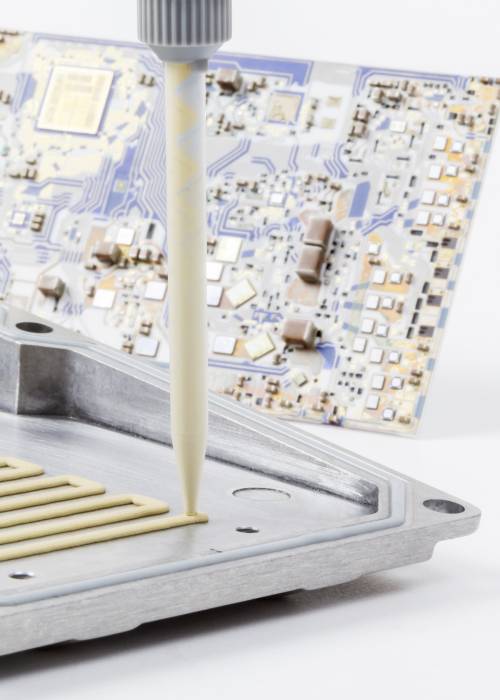
Dispensing is used to apply a long, wavy bead of gap filler to the heat sink of a power electronics module. A paste-like thermal interface material, SEMICOSIL® 961 TC is applied directly onto the heat sink. The electronic circuit is then placed on top of it and pressed down.
Overheating can damage the sensitive semiconductor structures of the IGBT and so lead to aging and eventually to component failure. Such failures can be prevented by actively cooling the printed circuit board (pcb) and IGBT assembly. It is necessary here to thermally couple the pcb to the cooling plate. If operating temperatures lie above 150 °C, a silicone-based thermally conductive material is the preferred choice – thermally conductive materials based on organic polymers cannot withstand this temperature load.
According to Dr. Markus Jandke, who, like his colleague Philipp Müller, heads an applications laboratory at WACKER SILICONES’ Industrial Solutions team: “The gap fillers in the SEMICOSIL® 96x TC series have proven to be optimal in numerous cases.” He emphasized that “Even non-curing silicone pastes such as SEMICOSIL® Paste 40 TC, which retains its consistency within the gap, or thermally conductive silicone adhesives such as SEMICOSIL® 9712 TC or 9754 TC can be used.”
The choice of material depends on how the pcb is connected to the cooling plate. This means that gap fillers and silicone pastes are predestined for such structures where heat sinks and heat sources, when in use, are screwed together or are otherwise securely connected by mechanical means and squeezed together. Thermally conductive silicone adhesives, in contrast, bond the two adherenss through their adhesive strength so that additional mechanical fastening is not required in many cases.
Even an electric motor generates heat during operation – despite a high degree of efficiency, which is generally over 90 percent. In comparison, combustion engines reach an efficiency of around 30 to 45 percent. Most of the heat is released in the stator, the stationary component of the electric motor. Various automobile manufacturers have decided to produce stator coil windings for future motor generations by using hairpin technology as this unconventional technology permits faster large-scale production.
“The gap fillers in the SEMICOSIL® 96x TC series have proven to be optimal in numerous cases.”
Dr. Markus Jandke, head of an applications laboratory at WACKER SILICONES’ Industrial Solutions team
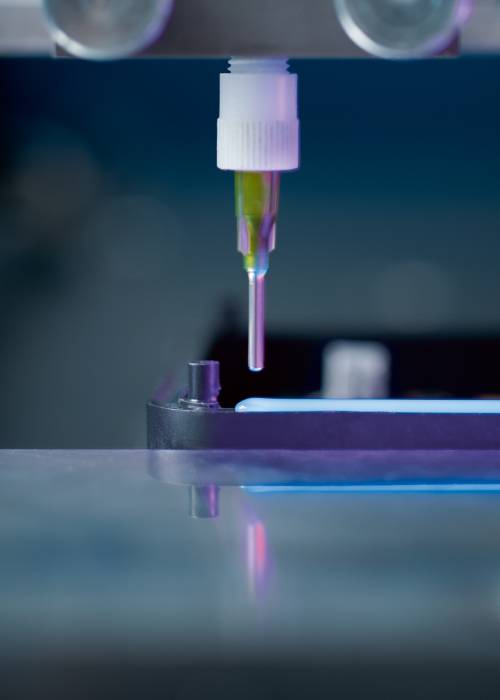
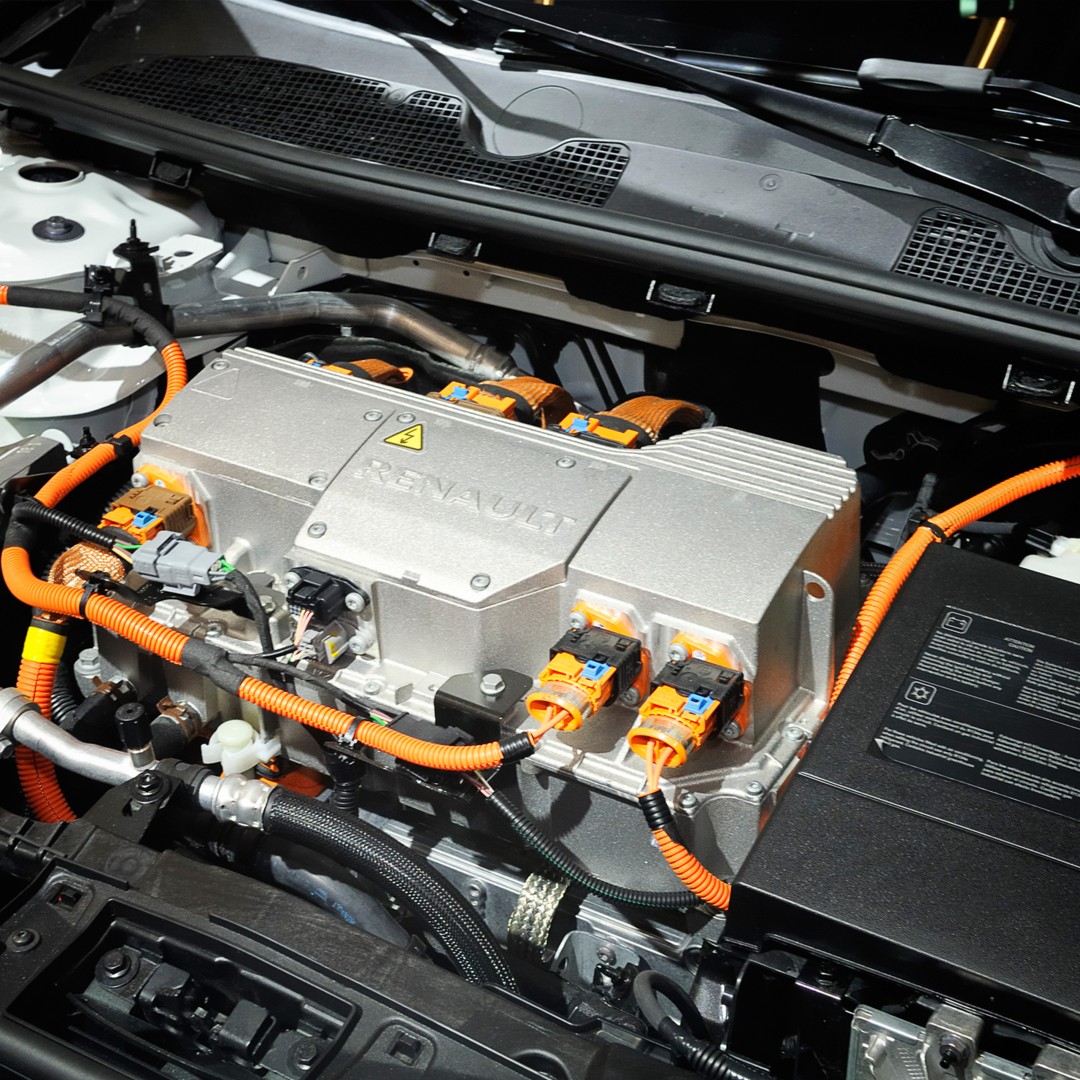
A peek into the engine compartment of a Renault Fluence: this vehicle was equipped with a traction battery that could be replaced at special stations. Time-consuming charging was therefore no longer necessary. The thick orange high-voltage cables are clearly visible under the engine hood.

Charging station in Berlin: the Mitsubishi iMiEV seen here has been in production since 2009 and was one of the first electric vehicles for the mass market.
There are two reasons why efficient heat dissipation is necessary in electric motors as well: firstly, the wire enamels used to coat the stator windings can age due to the heat. This must be prevented as the electrical insulation effect of the enamel is essential for problem-free motor operation. Secondly, permanently excited synchronous motors – a frequently used motor type – use magnetic materials derived from rare earth metals and some of these materials can lose their magnetic properties at temperatures above 130 °C.
In addition, the heat dissipated from the electric motor can be very readily deployed elsewhere, for instance to heat the passenger compartment and the windshield. This protects the battery and increases the range. Dr. Christian Ochs, another applications laboratory head at WACKER SILICONES, commented: “In this respect, it is also important to note that significantly less waste heat is normally generated in an electric vehicle. Intelligent systems for waste-heat utilization and insulation will therefore be used.”
Electric motor manufacturers are currently investigating various approaches to heat dissipation. “It is still unclear which one will prevail. But it is clear that thermally conductive silicone products can play an important role here,” said Dr. Ochs.
One such approach proposes transferring the waste heat from the stator via the laminated core (armature) – an important component in the stator – to the motor housing with the aid of a thermally conductive silicone resin. WACKER has developed the SILRES® H 68 TC silicone resin precisely for this purpose. The resin is so viscous at 60 °C that it can be easily trickled into the small gap between the copper hairpin and the stator sheets. Another approach to heat transfer uses the route along the copper hairpin toward the winding heads lying on the front of the stator. WACKER has an appropriate product for this application, too, as explained by Dr. Ochs: “In this case, a thermally conductive elastic silicone encapsulant such as ELASTOSIL® RT 744 TC can effectively support heat transfer.”
Other discussions involve whether the laminated core of the stator should feature small channels that coolant medium can pass through. The medium in this case could be a heat-resistant silicone fluid, such as POWERSIL® Fluid TR 50, which has been used for many years now to cool transformers. In comparison to water-glycol mixtures used for cooling in modern combustion engines, silicone fluids have the advantages of not being electrically conductive and of remaining free-flowing right down to -50 °C. Optimal cooling would therefore be ensured even during a cold start in the depths of Nordic winters.
An electric motor maintains a high torque across the entire speed range. The maximum torque is already available at speed zero in contrast to conventionally operated vehicles with transmission where torque increases up to a specific speed. Even with a comparably moderate motor performance, the electric vehicle achieves enormous acceleration from a stationary position, while the driver of a diesel or gasoline vehicle has to tediously shift gears – electric vehicles mean more driving fun, but also more frustration at gas stations. Even with a Tesla DC charger, also known as a supercharger, drivers need to wait 30 to 40 minutes until the battery is 80 percent charged.
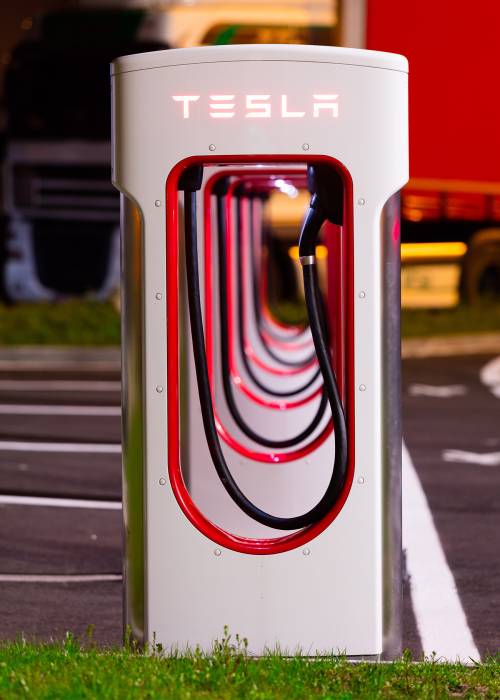
A rapid-charging Tesla station, or supercharger, at the Austro-Italian border: these superchargers can only be used by Tesla vehicles, however.
Many newspaper reports place electromobility on an equal footing with the utilization of electric vehicles. But electromobility is a whole lot more. It is based on a concept that goes far beyond just vehicles: this new form of mobility links the transport system with the energy transition, viewing electric vehicles as one component of a comprehensive and fully digitally networked mobility offering. A person favoring electromobility does not therefore simply use their own electric vehicle, but will, as a matter of course, also use car-sharing options or public transport.

Wireless charger for a smartphone: electric vehicles may be able to “top up” on electricity using the same principle in the future.
Protecting against the elements
Automotive manufacturers and their suppliers are hoping that electric vehicles will gain in appeal once the principle of inductive charging becomes more widespread. Charging is far more convenient with this wireless technology: drivers simply position their vehicles over a charging panel set into the ground. Although charging takes longer in this case, the process can be implemented with standard AC voltage systems. As soon as the vehicle is correctly positioned with the help of an electronic driver assistant, charging starts automatically. Such charging panels can be installed not only in garages, but also in customer parking lots. What’s more, visionary concepts envisage these installations at traffic lights, railroad crossing barriers or along traffic routes in general so that even fairly short stopping times could be used for charging.
This charging technology uses the principle of magnetic induction: high-frequency alternating current flows through a coil in the charging panel. The current is generated from a stationary AC voltage network by means of power electronic components. A second coil is located under the vehicle floor. Once both coils lie on top of one another, an alternating voltage is generated in the second coil. This is rectified by the vehicle’s on-board power electronics to charge the traction battery. The base plate and vehicle also contain electronic components that are networked via WLAN and which control the entire charging procedure. The efficiency of this contactless charging is today almost as good as charging with a cable.
The charging electronics are encapsulated to protect them against weather conditions and mechanical stress. WACKER offers a comprehensive range of encapsulants, sealants and adhesives for this purpose. These either rapidly cure at room temperature or at moderate temperatures or form bonds with the substrates involved – extremely interesting and important for innovative industrial-scale production. “Short production times are possible when our silicone products are used to manufacture electronic components. And the electronics are perfectly protected for many years under such rough operating conditions,” underlined Klaus Angermaier. Automotive companies are currently working intensively on the enhancement of inductive charging systems.
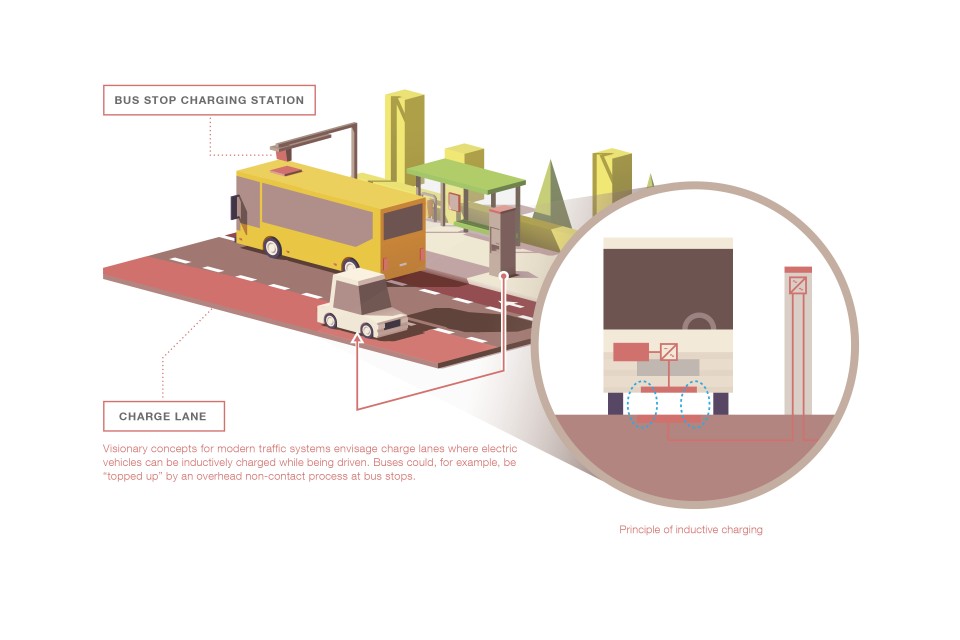
Charging while driving – with induction
Entering the electromobility age means that the automobile industry is undergoing an upheaval affecting the whole supply chain and supplier relationships.
A great many automotive manufacturers are, for example, intending to set up their own battery and motor production lines and will then purchase the necessary raw materials directly from the suppliers. This means that WACKER will continue to deliver silicone products – such as the thermally conductive gap fillers required for effective heat management – not only to automotive suppliers, but also directly to automotive manufacturers. In this regard, WACKER is working to obtain certification for the relevant production areas in compliance with the IATF 16949 standard which is applicable to all automotive suppliers.
Ultimate technical solutions have not yet been established with regards to the technical design of individual electric-vehicle components and charging-infrastructure details. “We do, however, clearly see today that silicones will play an important role in electromobility. Above all, they will help to ensure that key technical components function over the long term,” summed up Angermaier.
Contact
For more information on this topic, please contact:
Mr. Dr. Klaus Angermaier
Global Business Development
WACKER SILICONES
+49 89 6279-1453
dr.klaus.angermaier@wacker.com

